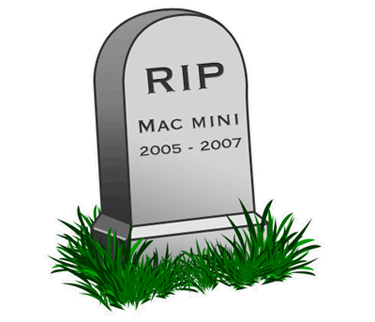Closing the book on Apple's Mac mini
Even while at the top of its game, Apple Inc. can seemingly find faults with just about anything, including a bit of itself. The Mac maker is constantly evaluating the market segments in which it wishes to participate and those which it does not. It's an application of love-hate methodology that inevitably produces its share of casualties.
Since then, the Mac mini has been treated to a rather mundane life-cycle. It has seen just four updates since inception, one of which was so insignificant in Apple's own eyes that the company didn't even bother to draft a press release. Even now, the current minis' 1.66GHz and 1.83GHz Core Duo processors are a far cry from the silicon offered in the rest of Apple's PC offerings. And rightfully so, as the company has seen lower margins from the units, which never gained the sales traction of its more fully equipped iMacs and MacBooks.
Some have gone so far as to call the mini Apple's bastard child; the neglected Mac that never was. At the same time, the history behind its creation and the reasons for its seeming abandonment are comparatively fuzzy. There is some speculation that Apple conceived the Mac mini under pressure from shareholders who wanted a sub-$800 Mac, but never really saw much in the design itself. It's almost as if the mini stood in direct contrast to Apple's fundamentals from the get-go.
In at least one instance, during the winter months of 2005 and early 2006, Apple began toying with concepts to more closely tie the mini to the essential nature of its business. The most public of those, per AppleInsider reports, was a plan to include a built-in iPod dock atop the high-end models. But just like every other bright idea Apple had for the tiny Mac, it was shelved and transformed under more economical standards into a project that would eventually emerge as Apple TV.
In fact, it was about that time in early 2006 when Apple TV really began to take shape inside Apple and the development of the mini began its slow, inevitable decline. Not coincidentally, Apple TV turned out a lot like a next-generation mini, with the stripping-out of the optical disc drive representing the essence of Apple's long-term digital media strategy.
Still, the mini has had its share of selling points. Due to its small footprint and low cost, it was immediately nominated by seasoned techies as the perfect media server for the living room. Some even went as far as installing the the tiny Mac in their vehicles. But with the advent of Apple TV, Apple seems to have shoved the diminutive device into the far corner of what had already been a niche audience.
Therefore, it comes as little surprise that sources, for whom AppleInsider holds the utmost respect, are now pointing towards the mini's impending demise. For it's according to those people that the miniature Mac will soon follow in the wake of its similarly-proportioned counterparts of years past: the PowerBook 2400, the PowerMac G4 Cube, and, most recently, the 12-inch PowerBook.
Whether Apple will squeeze another revision from the mini, and how long it plans to allow existing models to linger, are both unclear. But as the extended Memorial Day break dawns upon us, the point being driven should be clear:
Ladies and gentlemen, AppleInsider believes in all sincerity that the Mac mini is dead.
 Kasper Jade
Kasper Jade











 Mike Wuerthele
Mike Wuerthele

 Malcolm Owen
Malcolm Owen
 Chip Loder
Chip Loder

 William Gallagher
William Gallagher
 Christine McKee
Christine McKee
 Michael Stroup
Michael Stroup






